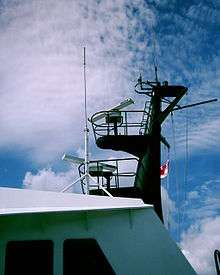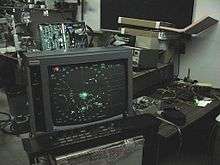Decca Radar
The Decca Radar company was a British manufacturer of radar systems.

History
The Decca Company, a British gramophone manufacturer that, as Decca Records, released records under the Decca label, contributed to the British war effort during the Second World War. This military engineering activity resulted in a number of commercial ventures after the war, in particular the Decca Navigator System, and the Decca Radar company.
Decca Radar launched its first marine radar, the 159, in August 1949. (The radar was named after the number of the London bus that passed the Brixton laboratory where the radar was designed and manufactured.) The company produced the first true motion radar (where the ship moves on the radarscreen and the map is static in comparison where the map is moving and the ship is in the centre of the radar display), the first anti-collision radar and the first "Type Approved" colour radar. China, as the third largest ship builder in the world, most ships it builds are equipped with navigation radars of Decca origin (either license produced or directly imported).
In 1959 Racal Decca, as the company was known then, launched a number of social and sports clubs. Racal Decca RFC of Tolworth still operates today, and plays at Kingston University Ground in Tolworth, Surrey.
Decca Radar was bought in 1979 by Racal Electronics forming Racal-Decca Marine and related companies. Early Racal-Decca radars had dropped the Decca name, but it was later restored. At this time the business was run from New Malden in Surrey. In the mid-1980s, Decca introduced the BridgeMaster series of radars, which used a rasterized colour display. The BridgeMaster II series followed, with a Motorola 68000 CPU and software options like vector traces showing the trajectories of other ships as part of the ARPA package.

In December 1996 the US corporation Litton Industries bought Racal-Decca Marine, as well as Sperry Marine and C.Plath, under the Litton Marine Systems name. The Decca name, engineering, and design continued to be used on the BridgeMaster II and, in 1998, the BridgeMaster E series of radars was launched. The Sperry section of Litton Marine Systems, based in Charlottesville, Virginia, was already producing its own line of marine radars, the Rascar, at the time of the acquisition but this was replaced by the BridgeMaster E. The Rascar had been the American-made radar used in the American Navy and Coast Guard but eventually the BridgeMaster E made inroads there as well. Competitors at the time included Gold Star and Furuno.
Northrop Grumman acquired Litton Industries in 2000 and this eventually heralded, in 2004, the end of the use of the Decca name on radars after a period of more than 50 years. In 2006 the VisionMaster FT series of marine radars replaced the aging BridgeMaster E series.